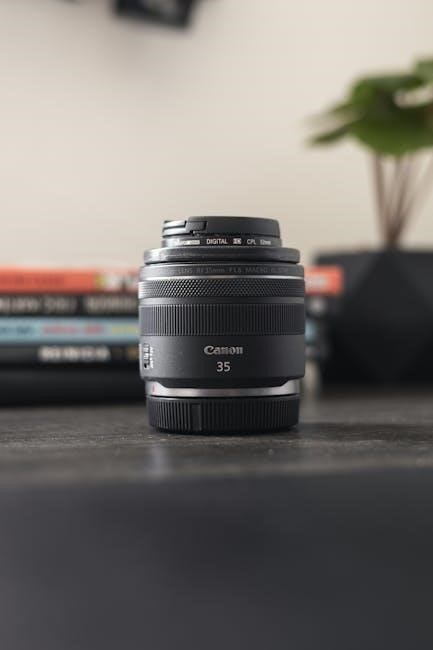The Canon EOS 7D is a high-performance DSLR camera featuring an 18MP CMOS sensor, Dual DIGIC 4 processors, and a 19-point AF system for precise focus control. It offers burst mode up to 8 fps, Full HD video recording, and a weather-sealed, ergonomic design, making it ideal for professional photographers and enthusiasts seeking advanced imaging capabilities.
Overview
The Canon EOS 7D is a high-performance DSLR camera designed for professional photographers and enthusiasts seeking advanced imaging capabilities. It features an 18.0-megapixel APS-C CMOS sensor and Dual DIGIC 4 image processors, delivering exceptional image quality and fast operation. The camera boasts a 19-point all-cross-type AF system for precise focus control and offers continuous shooting at up to 8 frames per second. With weather-sealed construction and an ergonomic design, the EOS 7D is built to withstand challenging shooting conditions. Its 3-inch LCD screen provides clear previews and intuitive menu navigation. Whether capturing stills or Full HD videos, the EOS 7D is a versatile and powerful tool for achieving professional-grade results.
Key Features
The Canon EOS 7D stands out with its 18.0-megapixel CMOS sensor, capturing detailed images with excellent low-light performance. It features Dual DIGIC 4 processors, enabling rapid image processing and responsive operation. The camera’s 19-point all-cross-type AF system ensures precise and fast autofocus, while its 8 fps continuous shooting mode excels in capturing dynamic action. The EOS 7D supports Full HD video recording at 1080p, with manual controls for enhanced creativity. Its weather-sealed body provides durability against harsh conditions, and the 3-inch LCD screen offers clear image previews. Additional features include a built-in flash, ISO range up to 6400, and compatibility with CF and MicroDrive memory cards. These features make the EOS 7D a robust choice for photographers seeking high performance and versatility in various shooting scenarios.
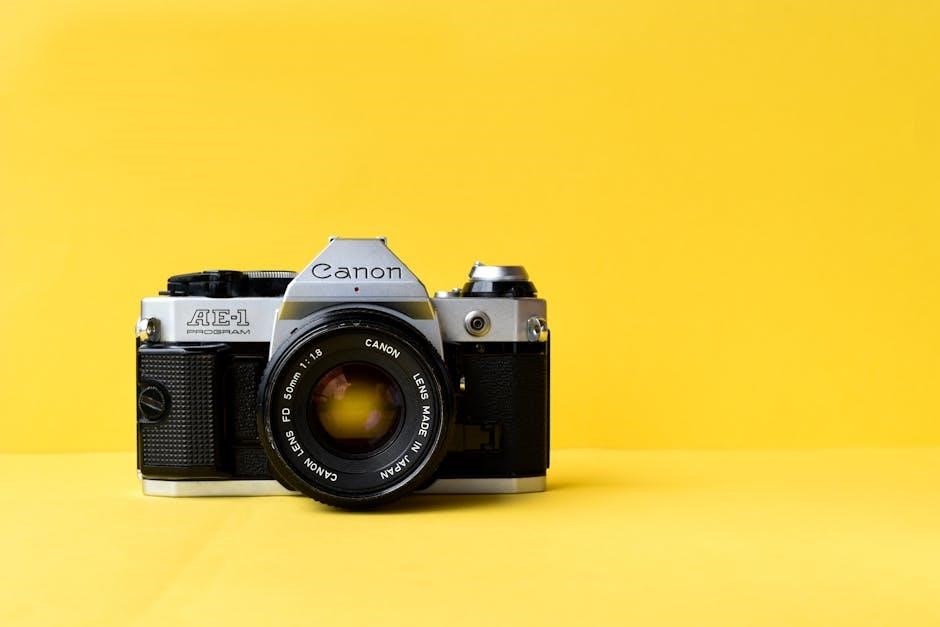
Product Specifications
The Canon EOS 7D features an 18MP CMOS sensor, Dual DIGIC 4 processors, and a 19-point AF system. It supports 8 fps burst mode, ISO 100-6400, and Full HD video recording.
Image Sensor
The Canon EOS 7D is equipped with an 18.0 megapixel CMOS sensor, designed to capture high-resolution images with exceptional detail and clarity. The sensor provides a maximum resolution of 5184 x 3456 pixels and supports an aspect ratio of 3:2, ensuring stunning image quality in various shooting conditions. With its advanced CMOS technology, the sensor offers excellent low-light performance, minimizing noise and delivering vibrant colors. This makes it ideal for both professional photographers and enthusiasts looking to achieve outstanding results in diverse photographic scenarios. The sensor’s capabilities are further enhanced by the Dual DIGIC 4 image processors, which work together to optimize image processing, enabling faster shooting speeds and improved overall camera responsiveness.
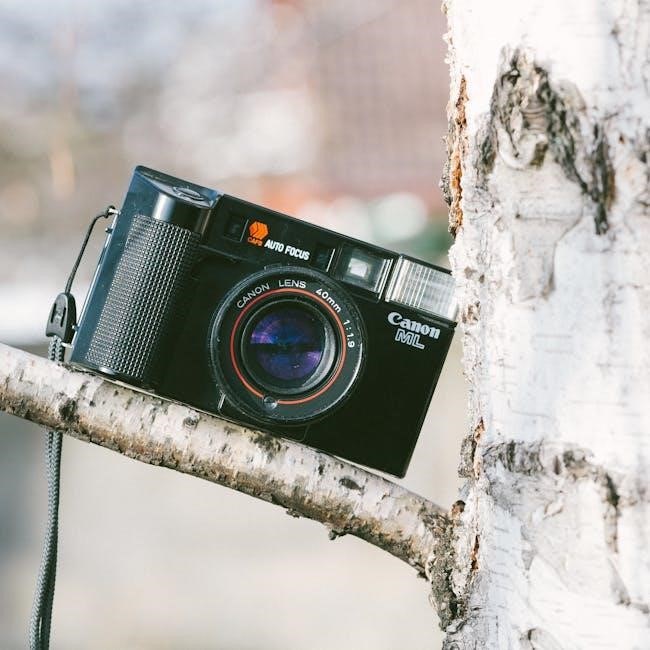
Processor
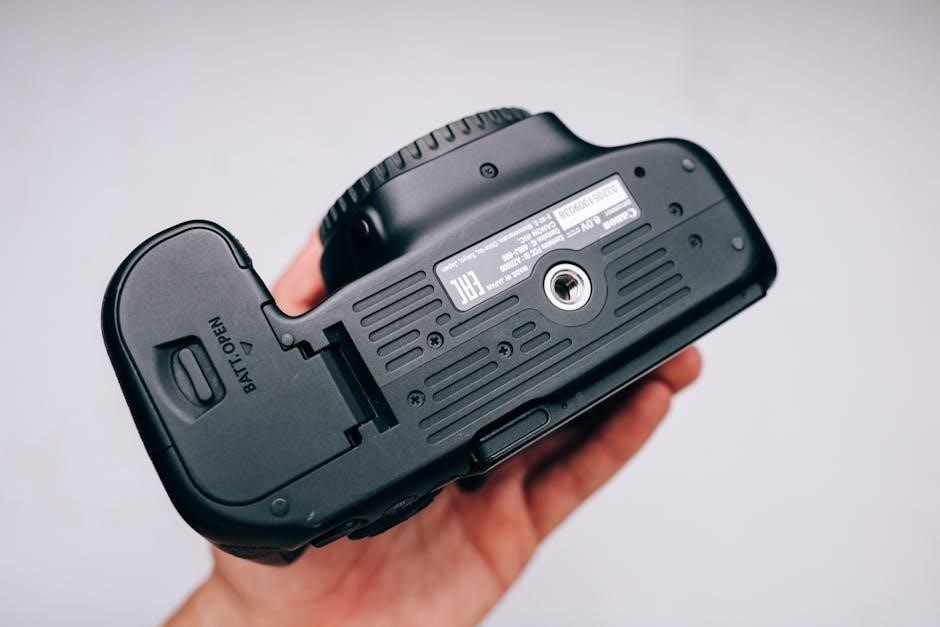
The Canon EOS 7D utilizes Dual DIGIC 4 image processors, which play a crucial role in enhancing image quality and camera performance. These processors work in tandem to handle the vast amount of data generated by the 18.0 megapixel CMOS sensor, ensuring rapid processing of high-resolution images. The Dual DIGIC 4 system enables features like continuous shooting at up to 8 frames per second and a wide ISO range of 100-6400, which can be expanded to 12800. Additionally, these processors improve autofocus speed and accuracy, allowing for quick and precise subject tracking. They also enhance video recording capabilities, supporting Full HD (1080p) video capture with reduced noise and improved color reproduction. The advanced processing power of the DIGIC 4 duo ensures smooth operation and responsive performance, making the EOS 7D a reliable tool for both still photography and video recording in demanding conditions;
Memory Cards
The Canon EOS 7D supports CompactFlash (CF) and microdrive memory cards, offering compatibility with high-capacity storage solutions. These cards are ideal for capturing large image files and extended bursts of continuous shooting. The camera is compatible with UDMA-enabled CF cards, which provide faster data transfer rates and improved performance during high-speed shooting. Using a high-speed memory card enhances the camera’s ability to handle rapid burst modes and ensures smooth operation during intensive tasks like video recording. The EOS 7D’s compatibility with various memory card manufacturers gives users flexibility in choosing storage options that meet their specific needs. Proper memory card management is essential for maximizing the camera’s performance and ensuring uninterrupted shooting sessions. Always format the memory card in the camera to maintain optimal functionality and prevent data errors. This feature ensures that the EOS 7D operates efficiently, even with high-capacity cards, making it a reliable choice for photographers who require robust storage solutions.
LCD Screen
The Canon EOS 7D features a 3-inch LCD screen with a resolution of 920,000 dots, providing clear and detailed previews of images and videos. The screen offers a wide viewing angle, making it easy to review shots even when the camera is tilted. The LCD supports Live View mode, allowing for precise focus control and composition; Brightness can be adjusted to suit various lighting conditions, ensuring visibility in both bright sunlight and low-light environments. The screen also displays key shooting information, such as aperture, shutter speed, and ISO, making it a useful tool for quick adjustments. Additionally, the LCD supports the 3:2 aspect ratio, matching the camera’s sensor, for accurate framing and composition. This feature-rich display enhances the overall shooting experience, offering convenience and flexibility for photographers of all levels. The EOS 7D’s LCD screen is a vital component for effective image review and camera operation.
Weight and Dimensions
The Canon EOS 7D has a robust yet lightweight design, weighing approximately 820 grams without the battery or memory cards. Its dimensions are 148.2mm in width, 110.7mm in height, and 73.5mm in depth, making it compact and easy to handle. The camera’s ergonomic design ensures a comfortable grip, allowing photographers to shoot for extended periods without fatigue. The lightweight and portable size make it ideal for both professional and casual photography, enabling users to carry it effortlessly during travels or outdoor shoots. The EOS 7D’s dimensions are well-balanced, providing a solid feel without compromising on portability. This design ensures that the camera remains accessible and user-friendly, catering to a wide range of photography needs. The weight and size are optimized for versatility, making the EOS 7D a reliable choice for capturing high-quality images in various settings. Its compact form factor and manageable weight enhance its overall usability.
ISO Range
The Canon EOS 7D features a flexible ISO range of 100 to 6400, which can be expanded to 12800 for capturing images in extremely low-light conditions. This wide range allows photographers to adjust sensitivity according to lighting environments, ensuring optimal image quality. The ability to shoot at lower ISOs, such as 100, is ideal for bright settings, minimizing noise and preserving detail. Conversely, higher ISO settings enable photography in dimly lit scenarios without additional lighting. While higher ISOs may introduce some noise, the EOS 7D’s CMOS sensor and DIGIC 4 processors work together to maintain image clarity and color accuracy. This adaptability makes the camera suitable for a variety of shooting situations, from outdoor landscapes to indoor events. The ISO range is easily adjustable via the camera’s controls, providing quick access to the desired sensitivity for any scene. This feature enhances the camera’s versatility for professional and enthusiast photographers alike.
Burst Mode
The Canon EOS 7D offers a robust burst mode, capable of capturing up to 8 frames per second (fps) in continuous shooting. This feature is particularly useful for sports, wildlife, and action photography, where freezing fast-moving subjects is essential. To activate burst mode, users can select the High-Speed Continuous option via the Drive Mode button, located on the camera’s top right side. The camera’s buffer allows for a generous number of consecutive shots, though the exact capacity depends on the file format and memory card speed. Burst mode is ideal for photographers who need to capture sequences of events, ensuring they don’t miss critical moments. The EOS 7D’s rapid firing capability, combined with its advanced autofocus system, makes it a powerful tool for dynamic and unpredictable shooting scenarios. This feature is a standout for professionals and enthusiasts alike, enhancing their ability to capture sharp, sequential images with ease.

Getting Started
Unbox and charge the battery, mount the lens, and familiarize yourself with basic controls. The manual provides detailed guidance for initial setup and operation of the Canon EOS 7D.
Unboxing
When unboxing the Canon EOS 7D, carefully remove the camera body, ensuring not to touch the image sensor. The package includes the camera, a battery, charger, neck strap, and a CD with software. For Lens Kits, the appropriate lens and its manual are also provided. The EOS 7D’s sturdy design and weather-sealed construction promise durability. The camera’s weight is approximately 820g, making it easy to handle. The LCD screen, measuring 3 inches, offers clear previews and menu navigation. Upon unboxing, check for all accessories and refer to the user manual for initial setup instructions. Proper handling ensures the camera’s longevity and optimal performance. Familiarize yourself with each component before proceeding to charging and setup.
Charging the Battery
Charging the Canon EOS 7D’s battery is a straightforward process. Locate the battery compartment at the bottom of the camera and remove the battery. Use the provided charger by placing the battery into it. Plug the charger into a power outlet and wait for the indicator light to change from red to green, signaling a full charge. Once charged, reinsert the battery into the camera, ensuring it is securely seated and the compartment door is closed. Avoid using damaged chargers and follow the user manual’s guidelines to prevent overcharging. Store the battery properly when not in use to maintain its capacity. Always handle the battery with care to ensure longevity and optimal performance.
Mounting the Lens
To mount a lens on your Canon EOS 7D, begin by ensuring the camera is turned off. Locate the lens release button on the front-right side of the camera body. Hold the lens by its sides, avoiding the glass elements, and align the white mounting index on the lens with the corresponding white dot on the camera’s lens mount. Gently rotate the lens clockwise until it clicks into place. This ensures the lens is securely attached. Once mounted, turn the camera on and check the lens information in the camera’s menu to confirm proper recognition. For zoom lenses, adjust the focal length using the zoom ring. Handle the lens with care to prevent damage and always use a lens cap when not in use. If the lens does not click easily, realign and try again gently to avoid damaging the mount.
Basic Camera Controls
The Canon EOS 7D features intuitive controls designed for easy navigation. The mode dial on the top right allows you to select shooting modes like Auto, P, Tv, Av, M, and custom settings. The main dial, located near the shutter button, adjusts settings like aperture, shutter speed, or ISO depending on the mode. The ISO button on the top left lets you quickly adjust sensitivity for low-light conditions. For focus control, the AF lock button ensures your subject stays sharp. The review button on the back lets you preview and delete images. Use the quick control dial to navigate menus and adjust settings efficiently. The live view button enables live view shooting for precise composition. These controls provide quick access to essential functions, making it easy to customize your shooting experience and capture high-quality images and videos.

Shooting Modes
The Canon EOS 7D offers various shooting modes, including Auto, Program AE, Aperture Priority, Shutter Priority, and Manual, providing flexibility for photographers to suit different creative and technical demands.

Mode Dial Options
The Canon EOS 7D’s mode dial offers a variety of shooting options to cater to different photography needs. The dial includes Auto mode, which simplifies photography by automatically adjusting settings, and Program AE mode, which offers more control while maintaining automatic adjustments. For advanced users, the dial features Aperture Priority, allowing control over aperture settings, and Shutter Priority, enabling adjustment of shutter speed to capture motion effectively. Additionally, Manual mode provides full control over both aperture and shutter speed for precise results. Other options include Burst mode for high-speed sequential shooting and Custom modes (C1, C2, C3), which allow users to save and quickly access their preferred settings. These modes enhance flexibility and creativity, making the EOS 7D versatile for various shooting scenarios.

Aperture Priority
Aperture Priority mode (Av) on the Canon EOS 7D allows users to set the desired aperture value, while the camera automatically adjusts the shutter speed to ensure proper exposure. This mode is ideal for controlling the depth of field, enabling photographers to isolate subjects or ensure sharpness across the entire image. To adjust the aperture, simply turn the main dial located near the shutter button. Turning the dial to the left decreases the aperture (higher f-number), increasing depth of field, while turning it to the right increases the aperture (lower f-number), creating a shallower depth of field. This mode is particularly useful for portraits, landscapes, and macro photography, offering creative control over the image’s aesthetic. The EOS 7D’s compatibility with a wide range of EF and EF-S lenses further enhances the versatility of Aperture Priority mode.
Shutter Priority
Shutter Priority mode (Tv) on the Canon EOS 7D allows photographers to set a specific shutter speed, with the camera automatically adjusting the aperture to achieve the correct exposure. This mode is ideal for capturing motion, as it enables control over the duration of exposure. Faster shutter speeds are suitable for freezing fast-moving subjects, while slower speeds create motion blur, adding artistic effects to images. To use Shutter Priority, rotate the main dial to select the desired shutter speed. Lower speeds (e.g., 1/30s) are best for creative blur, while higher speeds (e.g., 1/1000s) are optimal for sharp, action-stopping images. The camera’s automatic aperture adjustment ensures proper exposure, making this mode versatile for sports, wildlife, and dynamic scenes. Shutter Priority is a powerful tool for photographers seeking to master motion capture and creative image effects.
Manual Mode
Manual Mode (M) on the Canon EOS 7D offers full control over both aperture and shutter speed, enabling photographers to fine-tune their settings for precise creative results. In this mode, the camera does not automatically adjust exposure, allowing users to manually select the ideal aperture and shutter speed combination. This mode is particularly useful in challenging lighting conditions or when a specific artistic effect is desired. To adjust settings, use the main dial for shutter speed and the quick control dial for aperture. The camera’s LCD screen displays the selected settings and provides a histogram for exposure evaluation. Manual Mode is ideal for experienced photographers who prefer total control over their images, ensuring optimal results in various shooting scenarios. It is also a great learning tool for those mastering the fundamentals of photography.

Autofocus System
The Canon EOS 7D features a high-precision, high-speed 19-point AF system, all cross-type, ensuring rapid and accurate focus acquisition. Ideal for dynamic subjects and diverse shooting conditions, it delivers sharp results consistently.
AF Points
The Canon EOS 7D is equipped with 19 cross-type AF points, providing exceptional autofocus performance. These points are strategically arranged to cover a wide area of the frame, ensuring precise focus on subjects, even when they are moving or positioned off-center. Each AF point is sensitive and capable of detecting contrast in both horizontal and vertical directions, which enhances accuracy. The cross-type design allows for better performance in low-light conditions and with various lens types. Users can manually select individual AF points or use automated modes, such as AF point expansion, to track subjects effectively. This advanced AF system is particularly useful for capturing sharp images of fast-moving subjects, making it ideal for sports, wildlife, and action photography. The 19-point system offers flexibility and reliability, ensuring that photographers can achieve professional-grade results in challenging shooting environments.
AF Lock
The AF Lock feature on the Canon EOS 7D allows photographers to lock focus on a specific subject, ensuring sharp images even when recomposing the shot. By pressing the AF Lock button (*), located on the camera’s rear, focus is locked after achieving focus with a half-press of the shutter. This is particularly useful in portraiture and dynamic compositions where subjects are not centered. AF Lock prevents focus shifts when moving the camera, enhancing creative control; It is invaluable in genres like action and wildlife photography, where precise focus is critical. The feature ensures the subject remains in focus, allowing for more flexibility in framing and composition, thus improving overall image quality and artistic expression in various shooting scenarios.
AF Assist Beam
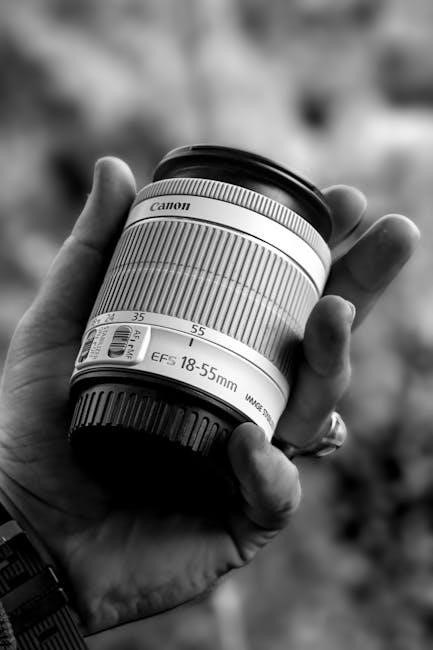
The Canon EOS 7D features an AF Assist Beam, part of its advanced autofocus system. This beam emits light in low-light conditions to aid the camera in focusing accurately. It’s particularly useful when the subject is poorly lit, ensuring sharp images. The beam is optional and can be turned off if desired. This feature enhances autofocus reliability in challenging environments, making it ideal for photographers working in dimly lit settings. It’s a practical tool that supports the camera’s focus capabilities, contributing to better overall image quality and user satisfaction in various shooting scenarios.
